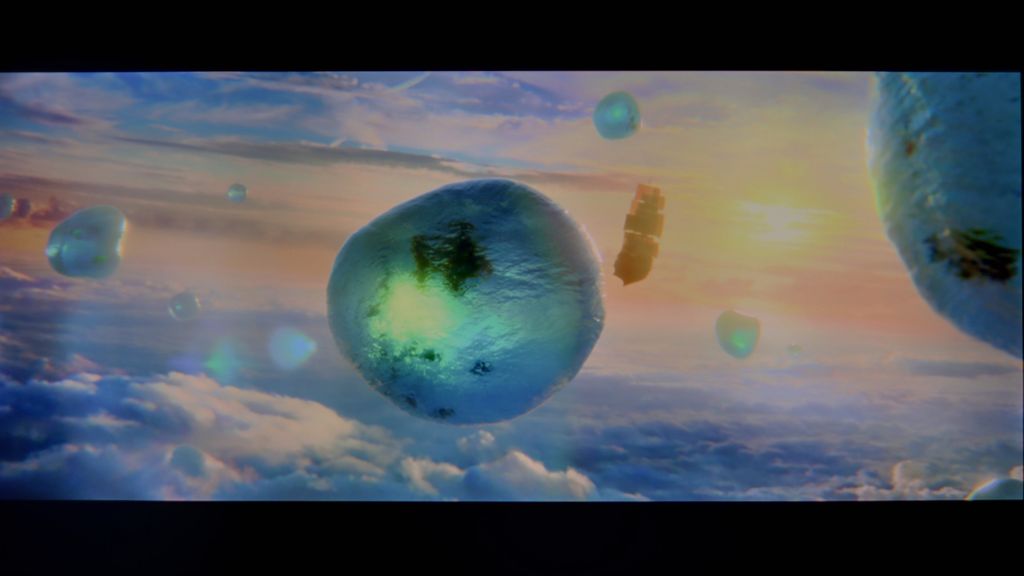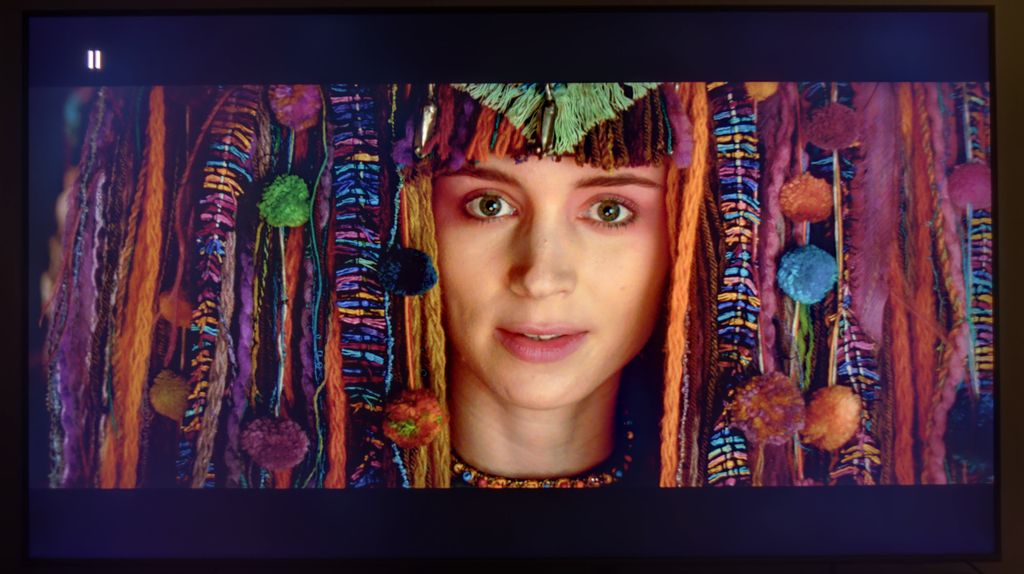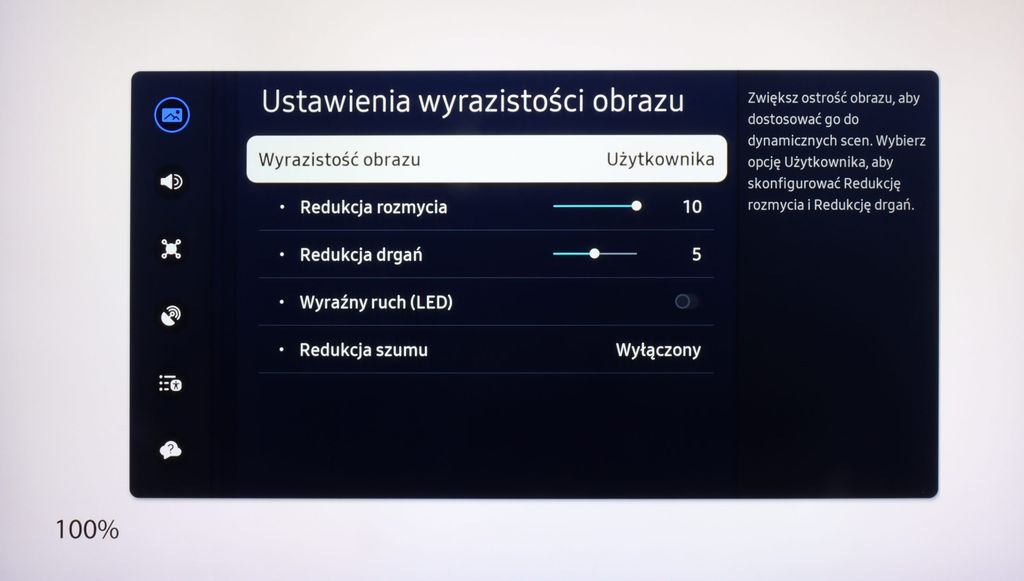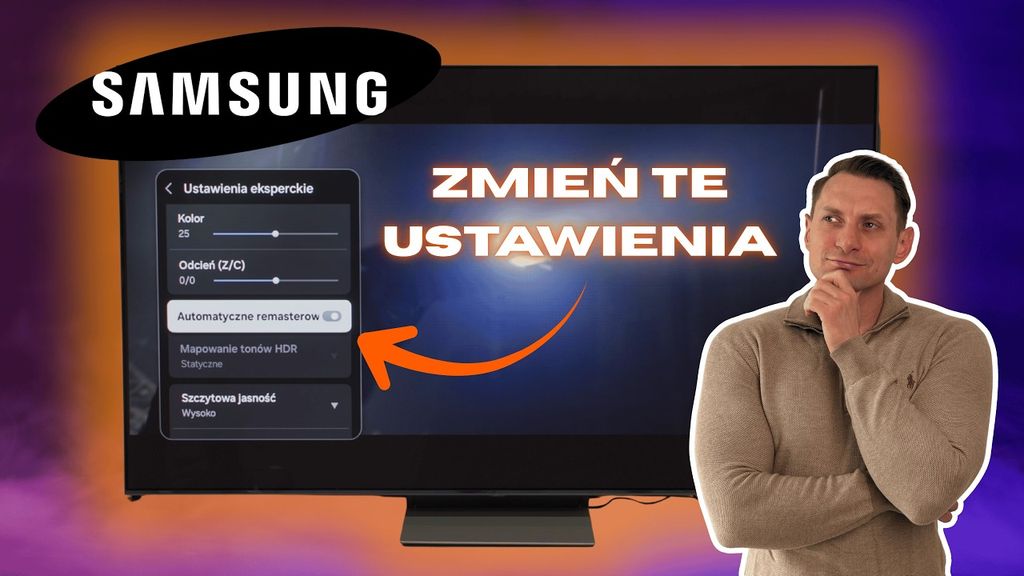Samsung Q70D test shows that the television offers clear dialogues and solid bass tones, which will satisfy most users. Moreover, in the Q74D model, the surround sound is automatically adjusted to the size of the room, making every movie more immersive.
- Matching (Score)
- Our verdict
- Competing TVs
- TV appearance
- Where to buy
- Contrast and black detail
- HDR effect quality
- Factory color reproduction
- Color reproduction after calibration
- Smoothness of tonal transitions
- Image scaling and smoothness of tonal transitions
- Blur and motion smoothness
- Console compatibility and gaming features
- Input lag
- Compatibility with PC
- Viewing angles
- Daytime performance
- TV features
- Apps
- Playing files from USB
- Sound
- Panel details
Samsung QLED Q70D / Q74D / Q77D Review
Q70D / Q74D / Q77D
Available screen sizes:

Complete the survey to find out the result
Panel type: LCD VA Refresh rate: 120Hz Brand: SAMSUNG Resolution: 3840x2160 System: Tizen Model year: 2024
SAMSUNG Q70D - Our verdict
6.8
Overall rating
The Samsung Q70D delivers solid performance for its price range, with standout features that will appeal to a wide range of users. Its gaming capabilities, in particular, are impressive, offering features like smooth gameplay and low input lag that make 30 fps titles feel like they’re running at 60 fps. The well-executed HGIG mode, which performs similarly to Dolby Vision, is another highlight for gamers. Additionally, the Samsung Q70D pairs easily with Canal+ decoders, a feature many other TVs struggle with.
When it comes to daytime viewing, the Samsung Q70D shines with bright SDR content that makes it ideal for well-lit rooms. However, there are a couple of downsides. The lack of Dolby Vision is noticeable, as the TV’s brightness could have benefited from it, and light leakage can be seen in dark scenes with low brightness settings. While these issues are not dealbreakers, they are worth noting.
On the plus side, the Samsung Q70D has one of the best motion smoothers in its class, making it perfect for sports or fast-action content. The system runs smoothly and has all needed apps. Overall, the Samsung Q70D is a strong addition to the manufacturer's seventh series, with consistent improvements in quality and growing popularity.
Advantages
Excellent performance with consoles and computers
Color reproduction after the calibration process
Very good efficiency in sports - advanced motion smoothing system
Smooth and trouble-free operation of the Tizen system
Very good quality of tonal transitions in this budget
Disadvantages
Possible noticeable light leaks
No Dolby Vision support
Movies and series in UHD quality
6.1
Classic TV, YouTube
6.0
Sports broadcasts (TV and apps)
6.5
Gaming on console
8.7
TV as a computer monitor
8.0
Watching in bright light
5.4
Utility functions
7.4
Apps
8.7
Sound quality
6.3
Complete the survey to find out what fits your preferences
SAMSUNG Q70D - Competing TVs in this price range
SAMSUNG Q70D - TV appearance
HDMI inputs: 0 x HDMI 2.0, 4 x HDMI 2.1 (40Gbps) Outputs: Toslink (Optical audio), eARC (HDMI), ARC (HDMI) Network Interfaces: Wi-Fi 2.4GHz, Wi-Fi 5GHz, Ethernet (LAN) 100Mbps
Build quality: Premium
Stand type: Central
Bezel color: Graphite







Stand: Fixed
Flat design: Yes
Accessories: Stand
Buy at the best price
Select size:
SAMSUNG Q70D - Contrast and black detail
5.4/10
Local dimming function: No

Result
2,450:1

Result
5,150:1

Result
6,550:1

Result
5,850:1

Result
2,800:1
Visibility of details in the lights:

The Samsung Q70D and its related models, like the Q77D and Q74D, feature a VA panel, which generally provides excellent contrast. Compared to IPS/ADS screens without advanced local dimming, the contrast on these models is several times better. However, the contrast results can vary significantly due to the non-uniformity of the panel. This means that sometimes the contrast is great, but at other times it can be noticeably worse, though it tends to remain fairly consistent overall, except for light bleeding.
To illustrate this, we look at two film scenes from "Oblivion" and "Revenant." In the first scene, the lights are well-separated, which is a positive as it suggests that detailed visibility in bright areas should be good in future tests. What stands out in this frame is the sharpness of the smoke under the light and the deep navy blacks in the background. In contrast, the second scene from "Revenant" reveals uneven backlighting, which is quite noticeable and impacts the overall image quality. Despite this, the details in the movie remained clearly visible.
Halo effect and black detail visibility:

SAMSUNG Q70D - HDR effect quality
5.5/10
Supported formats: HDR10, HDR10+, HLG Color gamut coverage: DCI P3: 92.2%, Bt.2020: 68.7%
Luminance measurements in HDR:

Result
433 nit

Result
461 nit

Result
477 nit

Result
475 nit

Result
490 nit
The brightness of the Samsung Q70D is fairly average, yet it delivers a noticeable HDR effect. With brightness exceeding 400 nits, the distinction between SDR and HDR materials becomes evident. As observed in the discussion about contrast and black levels, the TV's performance varies across different scenes. In a scene featuring a bright sun against a darker foreground, the measured luminance is lower. However, in a scene with a large, bright light source dominating the frame, the TV achieves its peak brightness, reaching nearly 500 nits—a commendable result for its price range and display class.
Despite these strengths, the relatively low coverage of the wide DCI-P3 color gamut occasionally results in less vivid color reproduction. Even so, the TV offers rich colors and precise shade reproduction, enhancing the movie-watching experience. Furthermore, the Q70D excels in motion blur elimination during dynamic scenes, making it a solid choice for enjoying sports broadcasts and gaming.
Scene from the movie “Pan” (about 2800 nits)

Scene from the movie “Billy Lynn” (about 1100 nits)

To thoroughly evaluate the televisions in our tests, we prepared two varied scenes designed to capture different aspects of image quality. The first, from the movie Pan, featuring light effects reaching up to 2800 nits, performed very well. The operation of the dynamic tone mapping function is clearly noticeable, ensuring that light effects beyond the television's range do not overwhelm the image. Although some detail loss in the clouds is evident, the result cannot be considered poor. However, the same cannot be said for the movie Billy Lynn, which appeared completely different from what was intended. The scene was significantly brightened, lacking its intended suspense and, more importantly, deep contrast. Additionally, there were substantial losses in colour fidelity, particularly in skin tones.
HDR luminance chart:
HDR luminance
Luminance of RGB colors
The tone mapping function in movies worked quite well; however, it is worth testing it in a more challenging scenario, such as scenes with a lot of white and fine details. In this case, it did not perform as effectively and failed to recover the missing details. The situation improves when an HDR signal supported by dynamic metadata is used, as this resolves the issue and reveals the previously unavailable details. Another drawback of the television, strongly evident in this scenario, is the uneven backlighting, which results in grey spots on an otherwise uniform background.
Static HDR10

Dynamic: HDR10+

Factory color reproduction
6.1/10
The best factory mode on the Samsung Q70D is "Filmmaker," and it is the one we used when conducting various tests. Before the calibration process, it had several flaws that effectively prevented the conveyance of the director's intentions. In both SDR and HDR materials, the white balance was dominated by red and green colors. As a result, there was a characteristic yellow tint on the image, causing whites to appear yellowed and creating issues with skin tones, which were noticeably too warm. The reduced gamma in the standard color gamut materials caused a significant drop in the already low contrast. This resulted in an emphasis on details in the blacks but also in blown-out images in brighter scenes. The EOTF curve, in this case, turned out to be much better and only lightened those scenes with relatively low luminance. This was clearly visible in the section where we measured the maximum brightness of the television in HDR materials. At that time, the frame from the movie "Billy Lynn" was unnaturally bright and lacking depth.
Color reproduction after calibration
8.1/10
Fortunately, Samsung provides a wide range of calibration tools in all its televisions, where we can find 2-point and 20-point grayscale adjustments as well as advanced CMS. Thanks to this, we were able to significantly improve the quality of SDR and HDR materials. The vast majority of errors have been corrected, and the image that the Samsung Q70D now generates is definitely closer to the reference. Higher deltaE errors in the high dynamic range materials are primarily due to the display's insufficient luminance.


SAMSUNG Q70D - Smoothness of tonal transitions
6.9/10
Considering how important light play is in films and series, the overlapping structures and the fluidity of tonal transitions are an extremely significant element in assessing image quality. The color grading on the tested television is at quite a decent level. It cannot be said that it is outstanding, but it is also not bad. We rate it as acceptable. Brighter scenes perform the best here, showing the least amount of stuttering. In scenes recorded in darker settings, slight deficiencies in grading can already be noticed; however, this is not an issue that would cause discomfort while watching. This may be disrupted by the bleeding backlight, clearly visible in the last photo.








Image scaling and smoothness of tonal transitions
7/10
Smooth transition function

Image without overscan on the SD signal

The function responsible for improving gradation is named "Noise Reduction" in the menu. As we have confirmed, it is worth activating as it has a positive effect on tonal transitions. More importantly, it does not negatively affect film grain or fine details, which sometimes the competition "offers" us.
Image scaling in Samsung Q70D should be rated as average. The manufacturer aims not to artificially sharpen the image but to leave it naturally softened.
SAMSUNG Q70D - Blur and motion smoothness
7.4/10
Maximum refresh rate of the panel: 120Hz
Film motion smoothing option: Yes
Blur reduction option: Yes
BFI function 60Hz: Yes, 60Hz (image flickers)
BFI function 120Hz: No
Brightness drop with BFI: 30%

The Samsung Q70D is the first model in the manufacturer's range to feature a 120Hz panel, resulting in more advanced motion smoothing capabilities compared to lower-category models. Within the menu, three functions are dedicated to improving motion fluidity: "Motion Blur Reduction," "Judder Reduction," and "Clear Motion (LED)." The third option will be discussed separately. The first function enhances sharpness during motion, while the second adjusts the degree of smoothing. The smoothness feature on the Samsung Q70D performs well, with each setting delivering a noticeable effect. This allows viewers to customise the level of fluidity, making it suitable for those who dislike the typical stuttering of films or enjoy watching sports. The accompanying picture illustrates a configuration with mild smoothing, avoiding the soap opera effect.
The panel employed in the Samsung Q70D offers a commendable response time for its class. While it won't deliver razor-sharp motion clarity, it is a strong choice for sports enthusiasts at this price point.
Blur (native resolution, maximum refresh rate):



Blur (BFI function enabled):
Image flickers in this mode



In the context of motion fluidity, the Samsung Q70D incorporates BFI (Black Frame Insertion) technology, which works by inserting a black frame between film frames. This technique aims to "reset" the retina, thereby improving image sharpness. However, the implementation of this feature leaves much to be desired. Activating BFI results in a significant drop in brightness and noticeable flickering. Additionally, this function exhibits specific flickering issues when displaying 50Hz content. As a result, we do not recommend using this feature.
SAMSUNG Q70D - Console compatibility and gaming features
9.5/10
ALLM: Yes
VRR: Yes
VRR range: 48 - 120Hz
Dolby Vision Game Mode: No
Correct implementation of HGIG: Yes
1080p@120Hz: Yes
1440p@120Hz: Yes
4K@120Hz: Yes
Game bar: Yes


The tested television, Samsung Q70D, has four HDMI 2.1 ports, all offering a bandwidth of 40 Gbps. Despite this, no negative effects were noticed during testing. More importantly, the TV supports all features associated with the HDMI 2.1 standard. This will certainly please gamers, as it ensures optimal gaming performance using a console or a PC. While HDR Dolby Vision is absent, the correct implementation of HGIG mode and the absence of any calibration checkerboard issues are noteworthy. Additionally, Samsung stands out by allowing gaming with the smoothness enhancer activated without significant performance degradation. This means that 30 fps titles are perceived similarly to those running at a native 60 frames per second.
Samsung was one of the first manufacturers to introduce the Game Bar, which has been consistently improved. It provides all necessary gameplay information and allows users to adjust "on the fly."
In summary, the Samsung Q70D performs excellently with both consoles and computers. All functions worked seamlessly, and there were no issues. The ability to activate the smoothness enhancer without a noticeable increase in input lag is a game-changing feature.



SAMSUNG Q70D - Input lag
10/10
The delay performance of the Samsung Q70D is excellent, regardless of the signal or resolution. Gamers will certainly appreciate the manufacturer's efforts, as a game running in 4K at 120 Hz with HDR experiences only 7 ms of delay, which is practically imperceptible even in online games. It is also worth noting that enabling the motion smoother doubles the lag, but it still provides a very comfortable gaming experience.
| SDR | HDR | Dolby Vision |
|---|---|---|
| 1080p60: 13 ms | 2160p60: 13 ms | |
| 1080p120: 7 ms | 2160p120: 7 ms | |
| 2160p60: 13 ms | ||
| 2160p120: 7 ms |

SAMSUNG Q70D - Compatibility with PC
8/10
Chroma 444 (maximum resolution and refresh rate): Yes
Font clarity: Very Good
Readability of dark text and shapes: Average
Input lag in PC mode (4K, maximum refresh rate): 13ms
Max refresh rate: 120Hz
G-Sync: Yes
After connecting the Samsung Q70D to the computer and using it as a monitor, input lag is impressively low at just 13 ms, making it virtually imperceptible in the mouse-to-screen experience. Thanks to the proper implementation of chroma 4:4:4, font readability is excellent, meaning the TV can confidently serve as a monitor for text-based work.
The subpixel arrangement is BGR, which doesn’t negatively affect using the TV as a monitor. However, since most operating systems are not designed for this subpixel format, it may result in slightly less sharp contours. This is a minor issue, barely noticeable to most users.
SAMSUNG Q70D - Viewing angles
2.9/10
Brightness drop at an angle of 45 degrees: 71%
Due to the VA panel, the Samsung Q70D struggles with off-angle viewing. Even a slight shift in position leads to a noticeable drop in contrast and a significant loss of colour accuracy.
SAMSUNG Q70D - Daytime performance
5.4/10


Panel finish: Satin
Reflection suppression: Average
Black levels during daytime: Good
The satin finish of the panel in Q70D allows for quite good performance in a heavily sunlit room. It is worth noting that reflections do not extend beyond their source, and thus do not spread over the rest of the panel. We also have good words for the maximum brightness of the TV in SDR materials, which is 450 nits, allowing for comfortable consumption of content during the day.
Panel brightness
Average luminance SDR
Samsung QLED Q70D / Q74D / Q77D: 449 cd/m2
SAMSUNG Q70D - TV features
7.4/10
System: Tizen
System performance: Good
- HDMI inputs: 0 x HDMI 2.0, 4 x HDMI 2.1 40Gbps
- Outputs: Toslink (Optical audio), eARC (HDMI), ARC (HDMI)
- Network Interfaces: Wi-Fi 2.4GHz, Wi-Fi 5GHz, Ethernet (LAN) 100Mbps
- TV reception: DVB-T, DVB-T2, DVB-S, DVB-S2, DVB-C
Classic features:
Recording to USB (terrestrial TV): No
Recording programming: No
Picture in Picture (PiP): Yes
RF remote control (no need to aim at the screen): RF
Backlit remote control: No
Teletext: Yes
Audio only mode: No
Bluetooth headphones support: Yes
Simultaneous Bluetooth headphones & TV audio: Yes
Smart features:
AirPlay: Yes
Screen mirroring (Windows Miracast): Yes
Voice search: Yes
Voice search in native language: Yes
Ability to connect a keyboard and mouse: Yes




The Tizen system powers the operation of the Samsung Q70D. It is a well-known software, as the manufacturer has been developing it for its televisions for a long time. Its main advantage is smooth operation and the absence of significant stuttering, which is confirmed by our tests. However, its biggest downside is its closed nature. Although the app store is quite extensive, users are still at the mercy of the manufacturer. As a result, we cannot install missing apps, even from a pendrive. On the other hand, an advantage—especially for Apple device users—is the implementation of AirPlay functionality, which allows easy screen mirroring from the device to the television. Thankfully, Samsung has also included the option to connect a keyboard and mouse for much faster navigation through the television menu. It’s worth noting that this year, the manufacturer has included a Bluetooth remote, which often wasn’t the case.
The Tizen system has another advantage: it integrates very well with external devices, such as the NC+ decoder or soundbars. The connection process is quick and doesn't require special skills. One of the standout features of the Samsung Q70D in our tests is the speed of application operation, with apps loading almost instantly and eliminating annoying delays. Additionally, users can utilize the built-in voice assistant, simplifying navigation and content searching.
In summary, the Tizen system is very efficient software and certainly a strong advantage of the television. While more advanced users may complain about the lack of apps like KODI, the majority will be satisfied.
Sound connection options
HDMI audio:
Other audio outputs:
Toslink: Yes
Wireless audio:
Bluetooth: Yes
Supported audio formats (external HDMI eARC audio):
Dolby Digital Plus 7.1: Yes
Dolby True HD 7.1: Yes
Dolby Atmos in Dolby Digital Plus (JOC): Yes
Dolby Atmos in Dolby True HD: Yes
DTS:X in DTS-HD MA: No
DTS-HD Master Audio: No
Senior accessibility
Numeric keyboard on TV: No
Font size adjustment: Yes
Audio description: Yes
SAMSUNG Q70D - Apps
8.7/10























SAMSUNG Q70D - Playing files from USB
9.1/10

| Maximum photo resolution: | Supported photo formats: |
|---|---|
The built-in player of the Samsung Q70D is a major advantage. It handled almost all video and audio files prepared for testing excellently. The only exceptions were the Dolby Vision format (which is not surprising) and some less popular codecs. On the positive side, the player supports Polish characters and allows users to change font colours. However, its performance with photo formats is lacking, as it only supports the popular JPEG format. Other formats, such as PNG or Apple's HEIC, are notably absent.
SAMSUNG Q70D - Sound
6.3/10
-
Maximum volume
Supported codecs
(TV speakers)
Dolby Digital Plus 7.1
Dolby True HD 7.1
Dolby Atmos in Dolby Digital Plus (JOC)
Dolby Atmos in Dolby True HD
DTS:X in DTS-HD MA
DTS-HD Master Audio
Constrained by its slim design, the built-in audio system of the Samsung Q70D is not particularly remarkable. The sound is relatively balanced overall, but increasing the volume beyond 2/4 of the scale is not advisable. On the other hand, for those with a home theatre system, the TV supports a range of audio codecs, including the most essential ones: DTS-HD Master Audio and Dolby Atmos.
Acoustic Measurements
No acoustic data
SAMSUNG Q70D - Panel details
Software version during testing: T-NKM2DDEUC-1053.2
Subpixel Structure:

Panel uniformity and thermal imaging:
Backlight Type: QLED

Founder and originator of the "ChooseTV" portal

Journalist, reviewer, and columnist for the "ChooseTV" portal
See articles related to Samsung QLED Q70D / Q74D / Q77D:
Our YouTube channel
Settings for Samsung QLED and OLED TV [Movies, Sports, TV, G... 10/16/2025
3/6/2025
12/1/2025
6/13/2025











